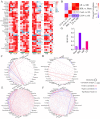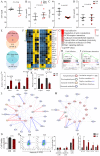Potential Crosstalk between Liver and Extra-liver Organs in Mouse Models of Acute Liver Injury
- PMID: 32174792
- PMCID: PMC7053327
- DOI: 10.7150/ijbs.41293
Potential Crosstalk between Liver and Extra-liver Organs in Mouse Models of Acute Liver Injury
Abstract
Carbon tetrachloride (CCl4), Concanavalin A (ConA), bile duct ligation (BDL), and liver resection (LR) are four types of commonly used mouse models of acute liver injury. However, these four models belong to different types of liver cell damage while their application situations are often confounded. In addition, the systematic changes of multiple extra-liver organs after acute liver injury and the crosstalk between liver and extra-liver organs remain unclear. Here, we aim to map the morphological, metabolomic and transcriptomic changes systematically after acute liver injury and search for the potential crosstalk between the liver and the extra-liver organs. Significant changes of transcriptome were observed in multiple extra-liver organs after different types of acute liver injury despite dramatic morphological damage only occurred in lung tissues of the ConA/BDL models and spleen tissues in the ConA model. Liver transcriptomic changes initiated the serum metabolomic alterations which correlated to transcriptomic variation in lung, kidney, and brain tissues of BDL and LR models. The potential crosstalk might lead to pulmonary damage and development of hepatorenal syndrome (HRS) and hepatic encephalopathy (HE) during liver injury. Serum derived from acute liver injury mice damaged alveolar epithelial cells and human podocytes in vitro. Our data indicated that different types of acute liver injury led to different transcriptomic changes within extra-liver organs. Integration of serum metabolomics and transcriptomics from multiple tissues can improve our understanding of acute liver injury and its effect on the other organs.
Keywords: acute liver injury; crosstalk; metabolomics; systematic change; transcriptomics.
© The author(s).
Conflict of interest statement
Competing Interests: The authors have declared that no competing interest exists.
Figures







Similar articles
-
NMR-based metabonomic and quantitative real-time PCR in the profiling of metabolic changes in carbon tetrachloride-induced rat liver injury.J Pharm Biomed Anal. 2014 Feb;89:42-9. doi: 10.1016/j.jpba.2013.10.023. Epub 2013 Oct 28. J Pharm Biomed Anal. 2014. PMID: 24252724
-
Shikonin Attenuates Concanavalin A-Induced Acute Liver Injury in Mice via Inhibition of the JNK Pathway.Mediators Inflamm. 2016;2016:2748367. doi: 10.1155/2016/2748367. Epub 2016 May 16. Mediators Inflamm. 2016. PMID: 27293314 Free PMC article.
-
Involvement of TGF-β1/Smad3 Signaling in Carbon Tetrachloride-Induced Acute Liver Injury in Mice.PLoS One. 2016 May 25;11(5):e0156090. doi: 10.1371/journal.pone.0156090. eCollection 2016. PLoS One. 2016. PMID: 27224286 Free PMC article.
-
High mobility group box chromosomal protein 1 in acute-on-chronic liver failure patients and mice with ConA-induced acute liver injury.Exp Mol Pathol. 2012 Oct;93(2):213-9. doi: 10.1016/j.yexmp.2012.05.006. Epub 2012 May 17. Exp Mol Pathol. 2012. PMID: 22609241
-
Crosstalk of liver immune cells and cell death mechanisms in different murine models of liver injury and its clinical relevance.Hepatobiliary Pancreat Dis Int. 2017 Jun;16(3):245-256. doi: 10.1016/s1499-3872(17)60014-6. Hepatobiliary Pancreat Dis Int. 2017. PMID: 28603092 Free PMC article. Review.
Cited by
-
Anti-Liver Fibrosis Role of miRNA-96-5p via Targeting FN1 and Inhibiting ECM-Receptor Interaction Pathway.Appl Biochem Biotechnol. 2023 Nov;195(11):6840-6855. doi: 10.1007/s12010-023-04385-1. Epub 2023 Mar 21. Appl Biochem Biotechnol. 2023. PMID: 36943602
-
Keap1 Deletion Rescues Cell Death Associated With Gpx4 Loss in Hepatocytes During Acute Liver Injury.Liver Int. 2025 Sep;45(9):e70210. doi: 10.1111/liv.70210. Liver Int. 2025. PMID: 40844245 Free PMC article.
-
Unveiling the flames: macrophage pyroptosis and its crucial role in liver diseases.Front Immunol. 2024 Feb 6;15:1338125. doi: 10.3389/fimmu.2024.1338125. eCollection 2024. Front Immunol. 2024. PMID: 38380334 Free PMC article. Review.
-
Inflammatory response to the ischaemia-reperfusion insult in the liver after major tissue trauma.Eur J Trauma Emerg Surg. 2022 Dec;48(6):4431-4444. doi: 10.1007/s00068-022-02026-6. Epub 2022 Jul 14. Eur J Trauma Emerg Surg. 2022. PMID: 35831749 Free PMC article. Review.
-
Oryza sativa L. Indica Seed Coat Ameliorated Concanavalin A-Induced Acute Hepatitis in Mice via MDM2/p53 and PKCα/MAPK1 Signaling Pathways.Int J Mol Sci. 2023 Sep 25;24(19):14503. doi: 10.3390/ijms241914503. Int J Mol Sci. 2023. PMID: 37833954 Free PMC article.
References
-
- Juza RM, Pauli EM. Clinical and surgical anatomy of the liver: a review for clinicians. Clin Anat. 2014;27:764–9. - PubMed
-
- Hu C, Li L. Improvement of mesenchymal stromal cells and their derivatives for treating acute liver failure. Journal of Molecular Medicine. 2019;97:1065–84. - PubMed
-
- Bernal W, Auzinger G, Dhawan A, Wendon J. Acute liver failure. Lancet. 2010;376:190–201. - PubMed
-
- Thawley V. Acute Liver Injury and Failure. Veterinary Clinics of North America: Small Animal Practice. 2017;47:617–30. - PubMed
Publication types
MeSH terms
LinkOut - more resources
Full Text Sources
Medical

